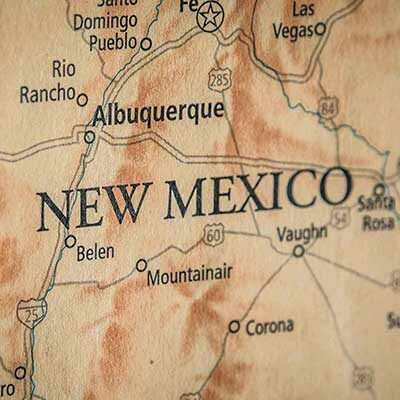Will the Biden administration be a ‘willing partner’ for communities on PFAS?
Laura Paskus
June 3, 2021
Recently, New Mexico Sen. Ben Ray Luján spoke with New Mexico in Focus correspondent Russell Contreras, who tossed into the conversation a couple of questions about PFAS.
New Mexico’s Democratic members of Congress have repeatedly called for the military to address groundwater contamination from Cannon and Holloman Air Force bases. That contamination is the result of the military's use of aqueous film forming foam (AFFF) containing PFAS.
“We had a lot of frustrations, many of us in New Mexico’s delegation, under the previous administration,” Luján said. “President Trump's Administration was not a willing partner in us moving policies.”
Earlier this spring, we spoke with Cannon officials, who noted the Air Force will not begin to test wells on and around the base until at least this Fall, to see where PFAS has spread since the results of a site investigation were released in 2018.
Now, according to a story at KLTV, the Air Force has awarded a $16.6 million contract pilot study at Cannon, where they plan to install a “small-scale water treatment system” to remove two types of PFAS from the groundwater. From the story:
The pilot study will bench test three different pump and treat filtration methods — granular activated carbon, ion resin exchange and a combination of the two.
The Air Force environmental team will use data gathered from the study to evaluate both near term interim actions and long-term treatment options for protecting the Ogallala Aquifer, said Christipher Gierke, the remedial project manager for the Cannon restoration effort.
Watch "Ben Ray - PFAS Update" for Sen. Ben Ray Luján's remarks.
President Biden has requested additional money from Congress to study PFAS—about $10 million above Trump’s previous $65 million request—and the U.S. Environmental Protection Agency has convened a PFAS Council.
It remains to be seen what the EPA will do under the Biden administration.
At NMPBS, we have an outstanding interview request with EPA experts to talk about the agency’s health studies and about how and when it might develop regulatory limits for the toxic substances—limits that would allow states like New Mexico to hold the military accountable for water pollution.
This week, an EPA spokesperson noted that granting an interview would be “premature,” but included an emailed statement that read, in part, “Cleaning up PFAS contamination is a Biden-Harris administration priority.”
Problems with AFFF “mutual aid”
Absent federal regulations, states and communities have tried in various ways to force the military to clean up PFAS contamination from bases. But it’s not clear what tools work. Especially as additional complications continue to arise.
Some state legislatures have passed pollution limits, other communities have appealed to the military’s big budget or sense of duty. In Michigan, legislators and residents seem to have tried all these tactics.
Reporting for MLive.com, Garret M. Ellison lays out a particularly troubling chain of events—which illustrate how hard it is for communities to find answers, let alone justice.
In March 2010, the state of Michigan became aware of PFAS contamination from Wurtsmith Air Force Base, according to the Michigan Department of Environment, Great Lakes and Energy.
Since then, taxpayers have spent tens of millions of dollars on cleanup, including for a groundwater “pump and treat” system. The military is also moving forward with developing additional cleanup plans – a “remedial action work plan” that includes a “baseline risk assessment” – and the state has continued to offer well testing to residents.
But the problems—and the tension between the military, the state, and locals—run even deeper.
As Ellison notes in a telling Twitter thread:
THREAD:
— Garret M. Ellison (@garretellison) May 26, 2021
In 1995, the Oscoda schools bus garage caught fire and @usairforce brought AFFF, a toxic fire foam used at Wurtsmith air base, to assist.
In 2018, the schools hooked to city water because groundwater was poisoned.
The Air Force refused to help. https://t.co/FQjNv095OD
In his reporting, he notes that the Wurtsmith AFFF was used off-base, too, as part of a mutual aid contract. Because of that mutual aid contract between the Air Force and local officials, the Air Force “claims it’s absolved of responsibility" for the PFAS contamination. (That MLive.com media briefing call is on YouTube.)
PFAS in breastmilk
Researchers who published a new study in the peer-reviewed journal, Environmental Science & Technology, analyzed breast milk samples from 50 women for 39 different types of PFAS.
The total PFAS concentration in breast milk ranged from 52.0 to 1,850 parts per trillion with a median concentration of 121 parts per trillion.
As a reminder, there are thousands of unique per- and polyfluoroalkyl substances. None of them are regulated in the United States, but the EPA did set lifetime health advisories for two of them, perfluorooctanoic acid (PFOA) and perfluorooctane sulfonate (PFOS) at 70 parts per trillion.
Let’s face it. There’s not a lot of good news when it comes to PFAS.
Contamination is widespread. PFAS aren’t broken down by sunlight, water, or even microbes, which means they persist in the environment. The toxic substances also bioaccumulate, moving up the food chain. And like with toxic metals such as mercury, breastfeeding mothers pass the contamination on to their babies.
But this study indicates when we stop manufacturing and using these toxic substances, there are benefits:
Analysis of the available breast milk PFAS data from around the world over the period of 1996–2019 showed that while the levels of the phased-out PFOS and PFOA have been declining with halving times of 8.1 and 17 years, respectively, the detection frequencies of current-use short-chain PFAS have been increasing with a doubling time of 4.1 years.
And while the U.S. doesn’t seem particularly close to setting standards—nevermind limiting the manufacture or use of products with PFAS—in 2019, the European Union released a strategy to phase out their use by 2030.
Just as a sidenote, in recent years, the American Academy of Pediatrics has continued to encourage nursing mothers to breastfeed, “even though a number of environmental pollutants readily pass to the infant through human milk, the advantages of breastfeeding continue to greatly outweigh the potential risks in nearly every circumstance.” And the Agency for Toxic Substances and Disease Registry has information on when to start a conversation with your doctor, if you're worried about PFAS exposure.
If you’ve been affected by PFAS contamination in your community here in New Mexico, call our tip line at (505) 433-7242. To read more coverage of PFAS in New Mexico visit “Groundwater War: New Mexico’s Toxic Threat,” which includes a timeline of events and studies on PFAS.






